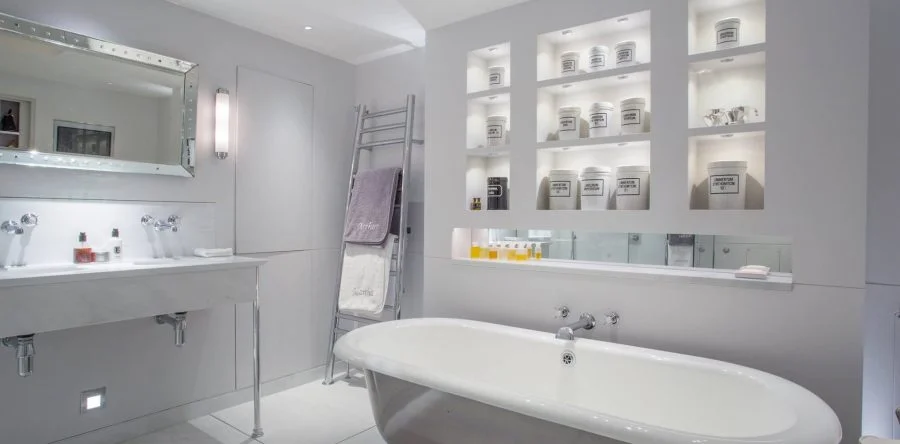Bring some much needed luxury into your home without any slip-ups!
With any home renovation project there are two keys rooms in the house that we all agree must hit the mark at all costs. The first is the kitchen and the second is the bathroom.
Whether you plan to build a luxury ensuite bathroom or want to make the main family bathroom in your home the centrepiece, there’s a great deal of pitfalls to avoid to prevent your dream pampering palace becoming an expensive and impractical nightmare.
So before you even choose a colour palette or call in the plumbers, here’s our breakdown of key mistakes to avoid when refitting any bathroom:
1. Unsuitable Materials
Whether its in the preparation or the final finishes, choosing the wrong materials can be a disaster for any bathroom refit. Every bathroom will have high levels of moisture so whether its the stud walls or plaster, ensure you use a water resistant substrate before any paint, tiles or finishes go onto any walls.
When it comes to the finishes, avoid using any materials that could be porous. Avoid veneers, cheap laminates on floors or chipboards on useable surfaces. If your room will be used for showering and baths, avoid wallpapers as they will peel and look tired and damage extremely quickly.
2. Poor Use of Space
Always understand the space that you are renovating and avoid trying to squeeze too much in. It makes no sense attempting to put a standalone bath in the middle of a small bathroom as it will dominate the space and make the bathroom impractical and unusable.
If the bathroom is small, look to using products that will maximise the space you have and allow you to move around freely. Corner showers and fitted baths are just as good and will allow you to add other vital pieces of furniture such as storage, shelves and mirrors without cluttering the area.
If you have a large bathroom, don’t be tempted to overload the space with as much as you can muster. Decide which products are your vital must-have’s and then find other supporting pieces that allow the centrepieces to shine.
3. Practical Use Not Considered
Always consider how everyone in the home will use the bathroom on a daily basis and get to know your own lifestyles. A new bathroom is supposed to make life better so if your current bathroom fails to work for you in its present form, make a list of the things that need improving and apply those to your new bathroom design.
For example if you have kids, a lower lying bath may be easier to get them in and out of the bath. If you’re thinking of the future or have elderly people in the home, perhaps a shower enclosure with a small seat could be a wise move.
4. Lack of Storage
The most commonly overlooked must-have in bathrooms is storage. Every bathroom will need a place to store medicines, soaps, shampoos, towels, mats and various other toiletries. When these all add up, you’ll be surprised just how much storage they require.
A good quality bathroom vanity or cupboard can usually take care of the smaller items whilst a well placed floor cabinet should be ample enough to store the larger items that can be easily accessed as and when needed.
If you do have room however, creating integrated storage cupboards is a far better way to hide away items that will make the bathroom feel roomier without cluttering up the space with bulky furniture.
5. Bad Lighting
Many bathrooms lack natural light and thus, the choice of lighting and where you position the lights is critical. If there’s no windows, good quality ceiling lights are a must to make the room feel bright and warm.
The bathroom mirror is the most commonly under lit area of the bathroom. Mirrors only reflect light, not create any so if the only source of light is from the ceiling, this will create shadows on the face, making applying makeup or shaving harder. A good quality backlit mirror will illuminate your face correctly and give you a clearer reflection.
6. Poor Choice of Tiles
Tiles come in all shapes, sizes and colours these days so the choice is extremely varied. If your bathroom is small, try to avoid darker coloured tiles as this will make the room feel dark and cramped. Try lighter tiles that are larger as this will make the room feel brighter, bigger and airy.
Avoid trying to mix too many styles of tiles into one room. Some of the best contemporary bathrooms limit the tiles to one or two styles throughout for both walls and floors. This will help to maintain a uniformed look and prevent the look becoming disjointed and a messy patchwork.
The choice of tile should compliment or contrast with with the bathroom furniture. So choose a simple colour palette that is sympathetic to overall scheme. This will create a classic timeless finish that should last for years.
7. Lack of Ventilation
Bathrooms get damp and moisture builds up fast. If your bathroom has no windows, a suitable ceiling extractor must be installed to prevent water damage to walls, lights and fittings.
Even when a window is present, good moisture extraction is vital as there will be many times throughout the year when your windows will remain closed during colder, winter months.
8. Bad Finishing Touches
Always have some budget left in the pot for finishing touches and the finer details. These final additions can really help pull the entire design together.
Many people overlook the importance of simple yet important objects such as door handles, hooks, window dressings including blinds and shutters, pictures or keepsakes – these all go a long way to giving the bathroom its personality and end finish. Without the right choices, the final look may be compromised and look lifeless or worse still – cheap and nasty!
9. Cutting Corners
It’s the classic mistake but everyone at some stage during a renovation has fallen into this common trap. Whether its hiring the wrong contractor or not hiring one at all!
Trying to take on a renovation project by yourself with little or no skill is a recipe for disaster. Why spend all that money on great products and then risk the finish by trying to skip around the finer details. It’s simply not worth the risk.
10. Scrimping on Budget
There’s an old saying that you get what you pay for. When buying bathroom furniture, fixtures and fittings, this is certainly the case.
There may be some great deals to be had out there that might seem appealing but seldom do cheaper, mass produced products last the test of time or make life any easier when it comes to fitting and final use. If you expect a really high end finish, you have to expect to pay a high end price – certainly in most cases that’s for sure!




